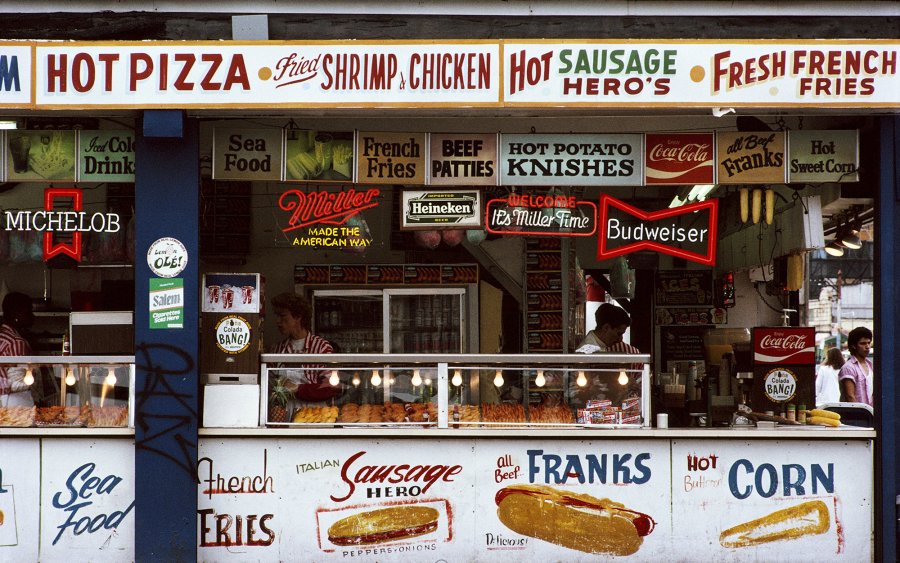IMAGES OF AVARITIA
Avaritia was not simply avarice but the greedy seeking, acquiring and private
accumulation
of liquid
wealth, especially by usury.
It was thus closely linked to Luxuria, or the depravity of luxury.
For more on the
Deadly (or Capital) Sins, read here.
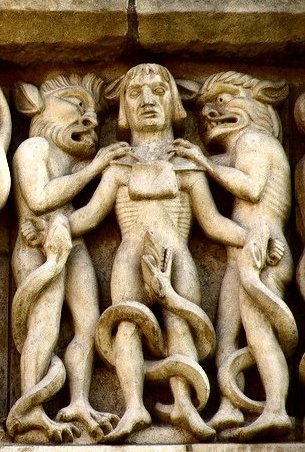
Lincoln Cathedral
A superb 11th.century capital at Ennezat (Puy-de-Dôme)
has the unambiguous inscription:
"in practising usury, you do devil-work".
He is being hauled to Hell by two figures in fringed skirts which don't
look particularly demoniac.
His Pot of Riches is bigger than the moneybag around his neck.
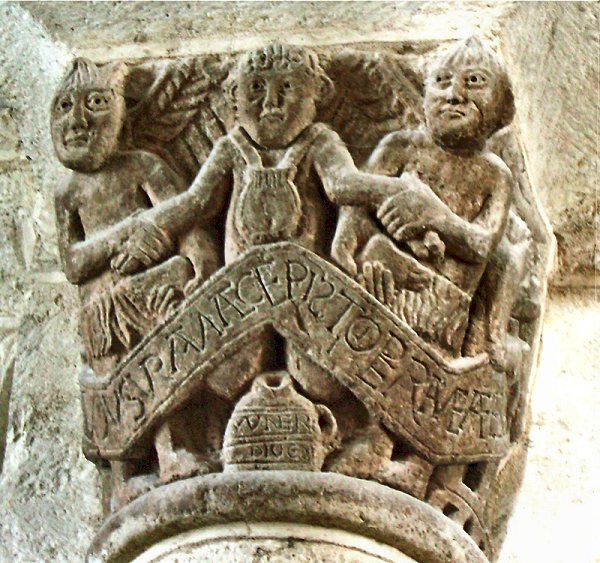
"Le supplice de l'usurier.
Il a sa bourse pendue à son cou et à ses pieds son pot de terre
abritant ses richesses.
Nu, il est empoigné par deux personnages démoniaques vêtus
d'un pagne.
La signification du message gravé est sans ambiguïté :
" en pratiquant l'usure, c'est pour moi que tu as travaillé
" fait dire le sculpteur à Satan."
(from Joël Jalladeau's excellent website : click
for more.
Saint-Fort-sur-Gironde: Mr Moneybag displaying his wealth.
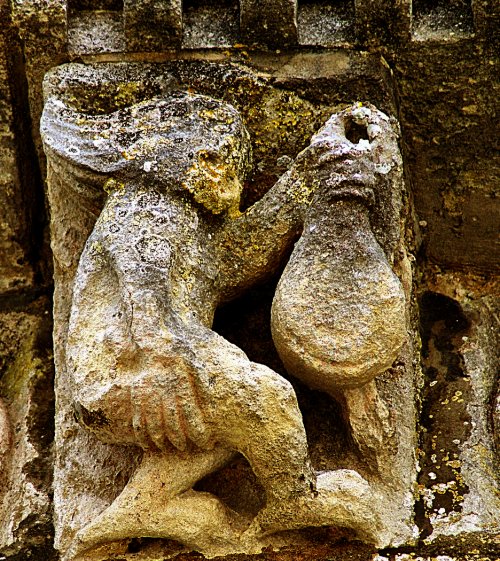
This splendid doubly-phallic 'Moneybags' at Parize-le-Châtel
(Nièvre) plays on the pun in Latin and French
on the word for scrotum and purse (bursa, bourse).
. A horned devil is peeking over his shoulder.
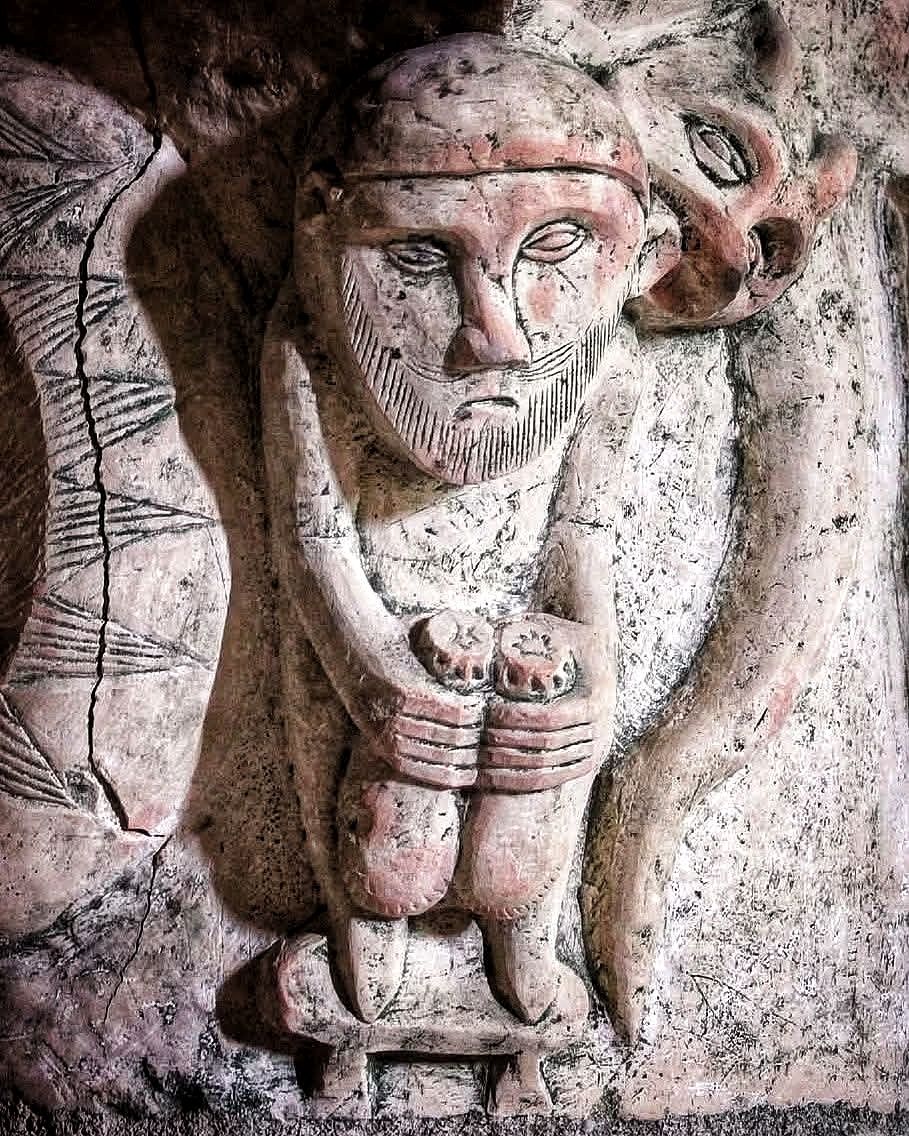
photo by -Fabio Casalini
A fine capital at Orcival (Puy-de-Dôme) is entitled
Foolish Rich Man in Latin.
He is being seized by demons who will cast him into the eternal fires of Gehenna.
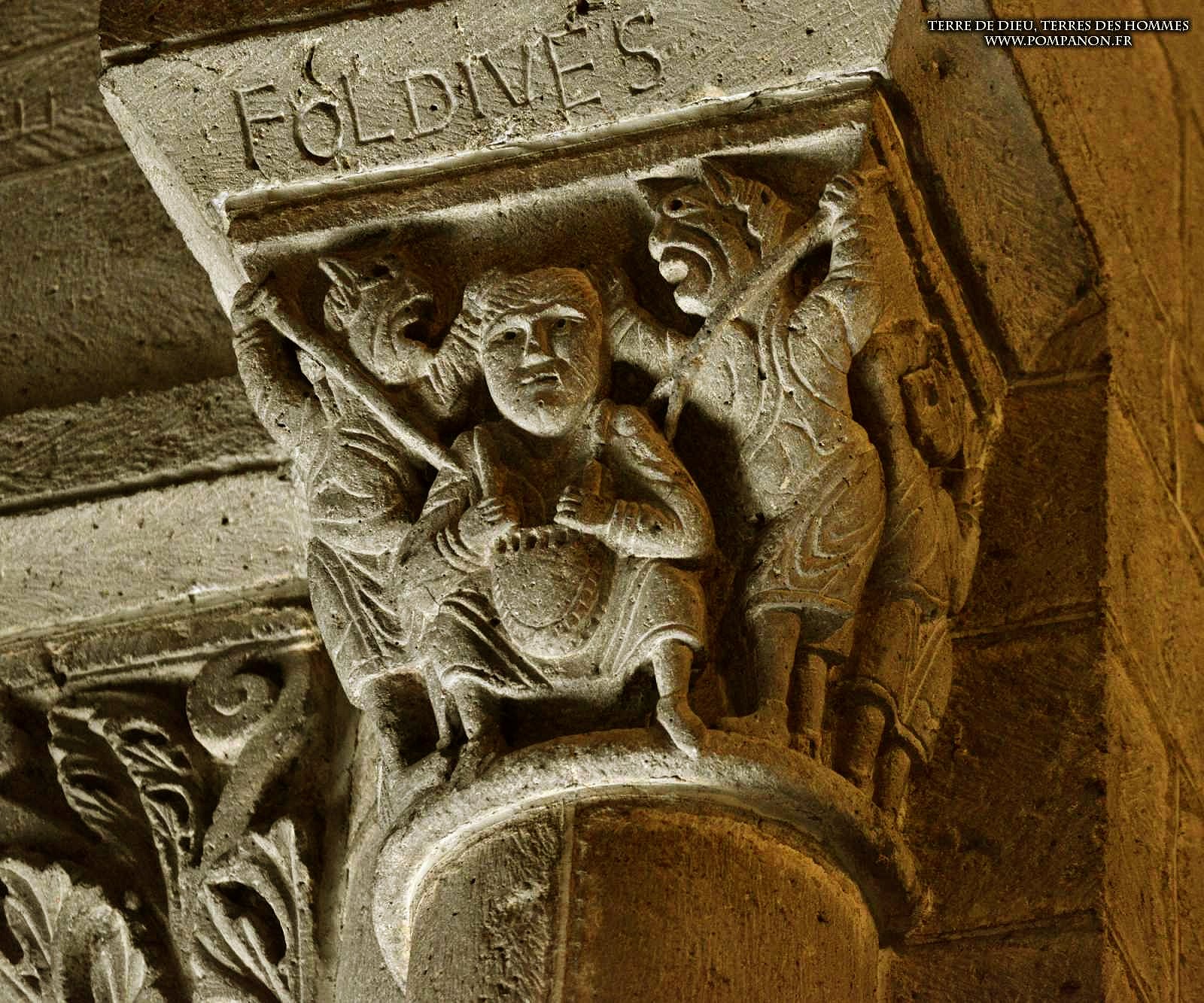
This bas-relief at Fornovo di Taro (Parma) leaves no doubt that the billionaires
will be punished eternally.
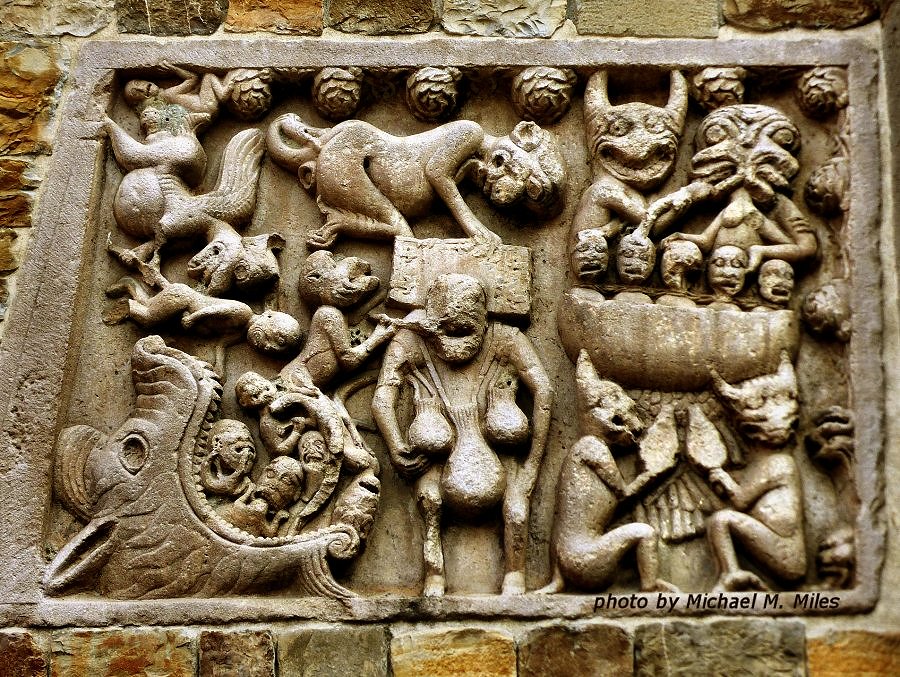
On an archivolt of the basilica of the Holy Cross in Bordeaux the hideously-evil
dealer or lender holds up a circular object,
which might be the pan of the scales that a devil is endeavouring to reove
from his grasp.
There is an implied parallel, of course, with the weighing of souls which
was another Romanesque trope,
most famous to Irish readers from Muiredeach's Cross at Monasterboice.
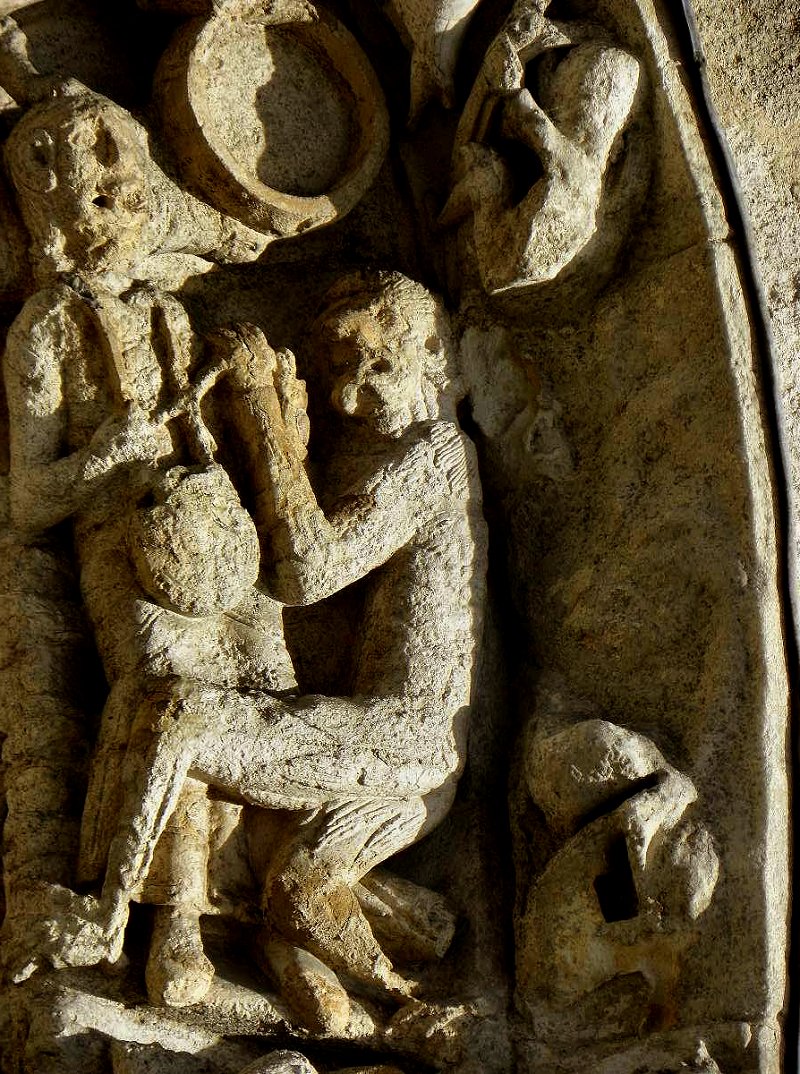
Avaritia rarely occurs on corbels, but there is
a fine example (with gold-measuring scales) at Cartes in Cantabria.
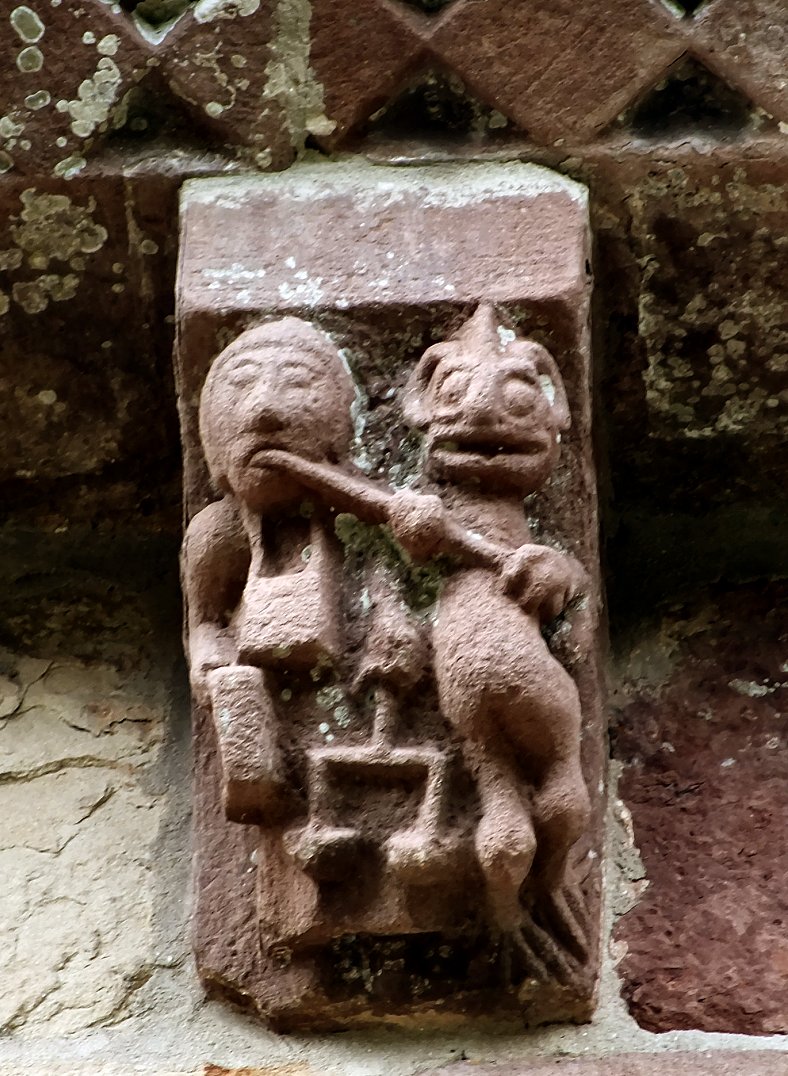
A much simpler representation of the irredeemable rich
can be seen at Carpiquet (Calvados).
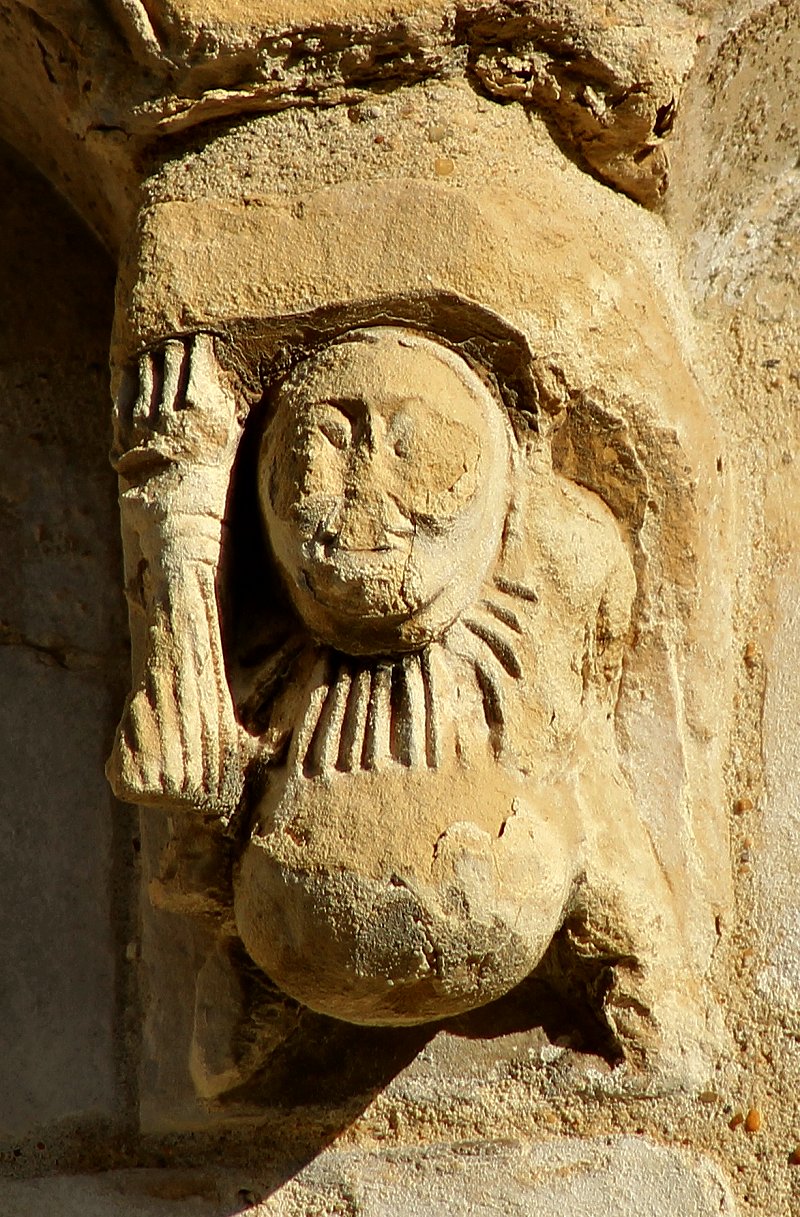
A moneylender (or banker) at Saint-Bertrand-de-Comminges
(Haute-Garonne)
is being swallowed by the jaws of Hell.
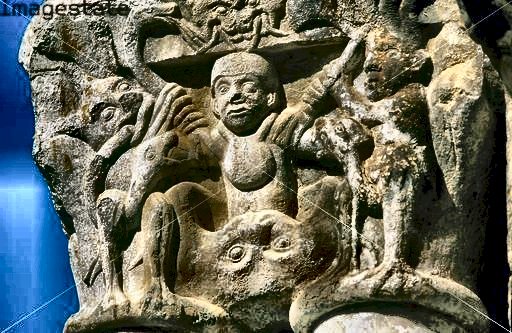
compare with the female hedonist at Saint-Antonin-Noble-Val
Rebolledo de la Torre (Burgos), Spain:
an unusual lion-maned devil welcomes the skinny (maybe miserly) rich man to
Hell.
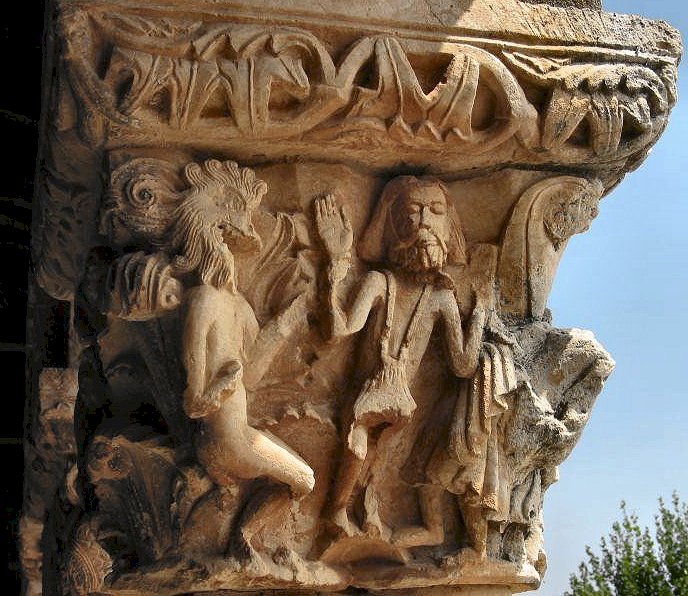
|
Male
exhibitionist with moneybag, Domfront (Orne) France:
the sin of wealth leading to the sins of licentiousness and concupiscence.
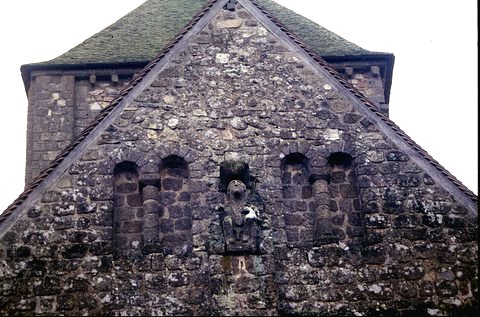
In the Old Testament, the charging of interest by Israelites was forbidden
to fellow-Israelites - but not to Gentiles. (Exodus
XXII,25; Deuteronomy XXIII,19-20; Leviticus XXV, 36-37; Ezekiel XVIII,8;
Psalm XV,5.) The authors of Deuteronomy desired remission of
debts every seven years in order to prevent the debt-slavery which unfailingly
accompanies usury.
While usury
is not condemned as such in the New Testament, Jesus was obviously concerned
about the exploitation of the poor by the rich, about continuing, crippling
debt and its remission. Moneylenders and wealth are both condemned in
the Gospels, and money itself denounced byJames and Timothy. The chief
and most certain source is wealth is by lending money - whether to the
poor or to 'entrepreneurs', 'venture capitalists' or to
already-rich companies and corporations.
The early
'Church Fathers' condemned Usury as the opposite of Charity, Augustine
regarded it as a crime, and the Council of Carthage banned it in 345 AD.
The Third Lateran Council of 1179 denied moneylenders Christian burial.
But there
was a commercial revolution during the period from 1100 to 1348 (The Black
Death) brought about by the general use of the bill of exchange (essentially
paper money) which avoided sacks of coins being transported and sunk in
boats or seized by brigands. Each bill was a loan that also performed
a currency conversion. A merchant would use local currency to purchase
a bill of exchange. That bill was then made payable at a future moment
in time, in another location, and in a different currency. The interest
rate charged by the lender was not recorded but rather subsumed under
the currency-exchange conversion. (Visa and Mastercard used
the same trick until litigation required them to disclose foreign transaction
fees on customers’ statements.) This was interpreted as usury, which
led to wealth, luxury and depravity - and the economic decline of the
monasteries and monastic orders.
In 1524
Martin Luther condemned usury as grossly contrary to God's Word -
but just 20 years later, Calvin, the Whited Sepulchre of Geneva, started
to write apologies for money-lending. From that point modern Capitalism
began to take over the world.
Today, even
'Bible-based' Christians see nothing wrong with the charging of
interest - which they would call making money make money. They
continually and ever-more irrelevantly condemn private behaviour such
as harmless homosexuality on the basis of dubious interpretation of very
few texts, but conveniently ignore the prohibition of usury in both Old
and New Testaments... They are akin to the anti-Darwinists who are the
most avid exponents of "Social Darwinism".
|
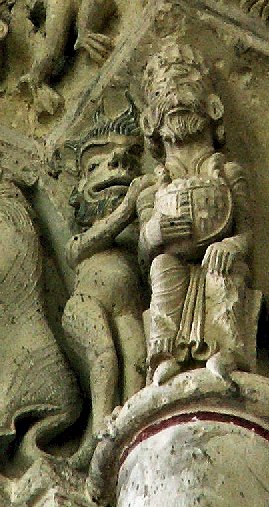
A fine capital at Cunault (Maine-et-Loire) showing a devil
claiming
a king or prince with impressive moneybag.
photo by Julianna Lees
And an amazing depiction of the despicable rich man at Tarragona
in Spain,
which links this motif with tongue-stickers,
mouth-pullers and Gorgons.
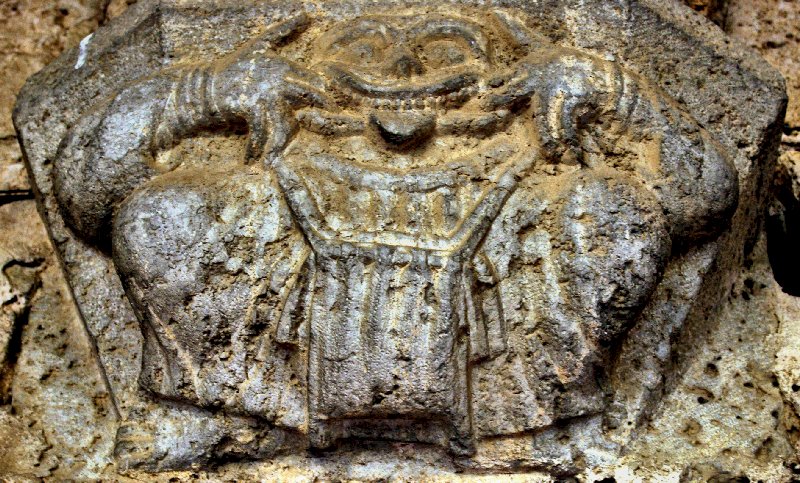
The theme of wealth, greed, and ungenerosity features large
on the left side of the famous portal at Moissac (Tarn-et-Garonne).
Below the most descriptive of all the depictions of the parable of Dives
and Lazarus
is this panel. On the left, a tongue-sticking demon sits on the shoulders of
a rich, beautifully-dressed aristocrat seated on a chair
and holding a large bag (grey with white staining). The devil's talons grip
his forehead.
On the right - Scene 2 - another devil sits on his shoulders while gripping
the bag.
The rich., vainglorious man is now a pauper and will be a pauper in Hell.
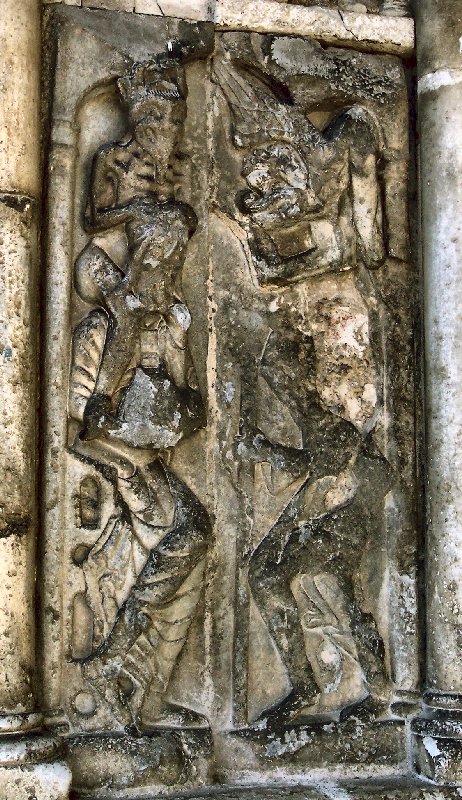

On the W door of Lincoln Cathedral in England, a rich woman
wearing pearls is handing a box (containing jewels ?)
to a rich man with a satchel, who may be a moneylender or a tax-collector.
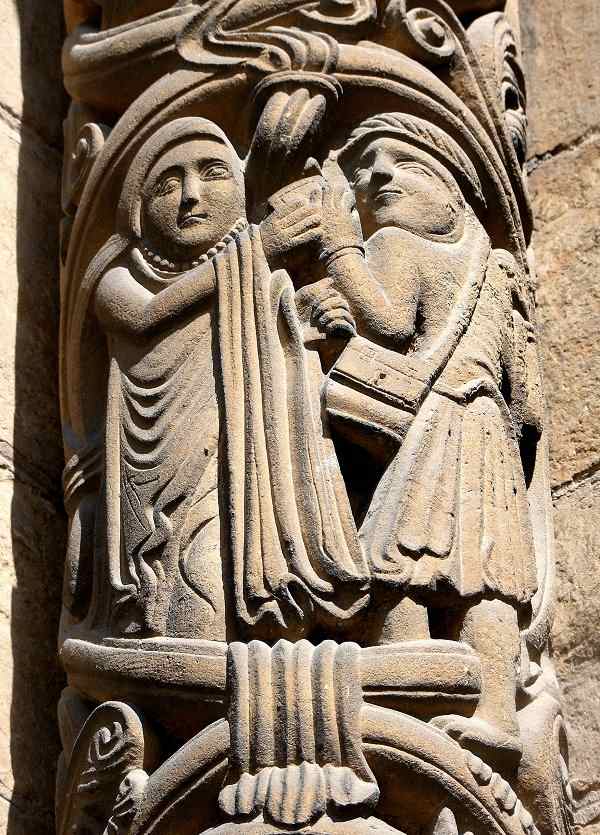
And on the recently-restored frieze is this rich man being seized by two devils
who will drag him to Hell.

A corbel at Mailhat (Puy-de-Dôme) shows a person with a moneybag
who seems to be a rogue monk.
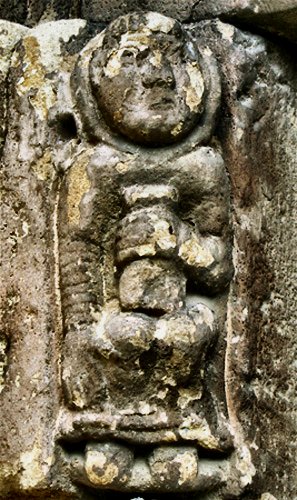
From the same church a figure of the eternal punishment of Luxuria,
the Licentiousness of the Rich.
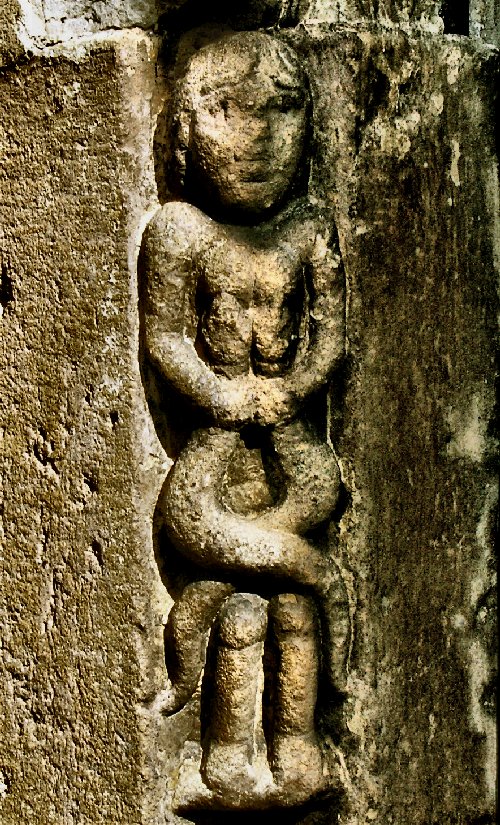
Fragments at Beaulieu-sur-Dordogne (Corrèze), photographed
by Adrian Fletcher.
The rich man is being ridden into Hell by a devil, while a toad-lizard approaches
Luxuria's groin.
The figure on the left may be Gluttony, having 'licked the platter clean'.
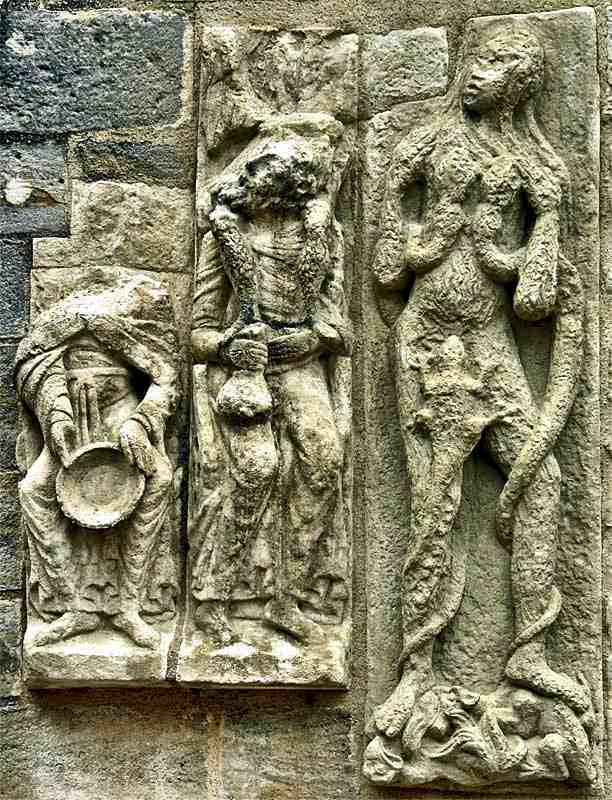
A tongue-sticking, possibly-hermaphrodite, chained devil
on one of the three West Doors of Notre-Dame de Paris.
Note that he is sitting on a pope, a wealthy cardinal, and a king.
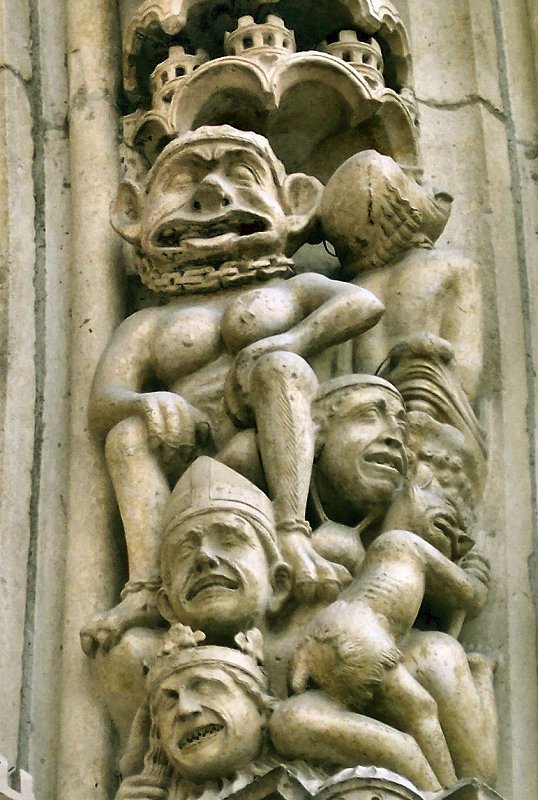
A more horizontal version at Strasbourg cathedral shows similar
characters advancing reluctantly towards the jaws of Hell,
with the (very German-looking) wealthy man the most prominent of the damned
because of his money-bag.
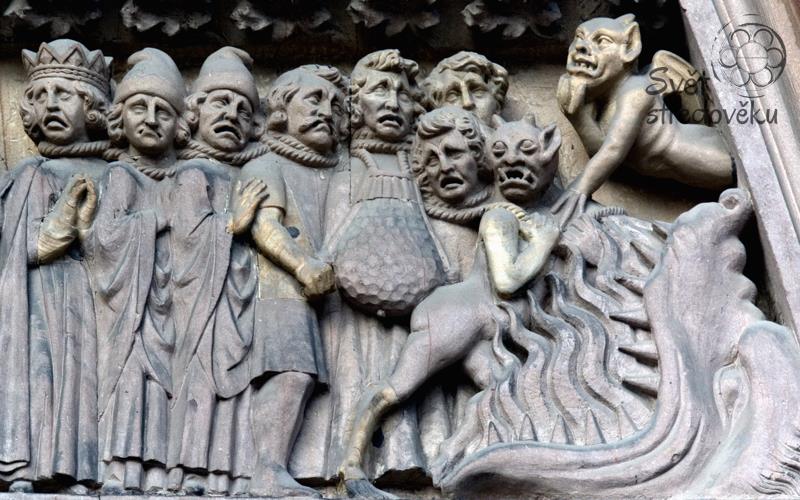
<<
BACK<<
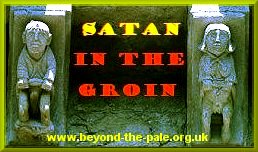

Gluttony was another notable sin, of course, but it
was rare,
and it would take several hundred years - and the advent of consumer-capitalism
- for it to become generalised.
